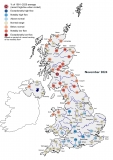Submitted by Steve Turner on
For the UK as a whole, August 2018 was fairly typical – rainfall was near-average and it was slightly warmer than average – contrasting with the exceptional June and July. These heatwave-dominated months led to summer 2018 being the joint warmest on record for the UK. Warm, dry conditions extended into early August, as a persistent northward meander of the Jetstream continued to deflect rain-bearing systems to the north. As this pattern broke down, most areas of the country saw welcome rainfall, easing widespread agricultural drought stress and leading to modest river flow responses. Nevertheless, August was dry in some regions (e.g. Yorkshire and North East Scotland) and even in areas with abundant rainfall, soil moisture deficits remained significantly above average. August river flows were generally in the normal range or below, and groundwater levels were mostly in the normal range. While water resource pressures associated with high consumer demand eased as temperatures dropped (the planned temporary use ban for United Utilities was cancelled on the 2nd), reservoir stocks continued to fall and were more than 20% below the late August average in Wales (e.g. 29% below for the Elan Valley) and parts of the Pennines (e.g. 27% below for Derwent Valley). Combined stocks for England and Wales were the fourth lowest for late August in a record from 1988. The impact of the summer 2018 meteorological drought continues to be felt (canals remained closed in parts of northern England due to levels in feeder reservoirs) and water resource concerns remain in some northern and western areas. The outlook for groundwater is generally healthy entering the recharge season. The longer-term water resources outlook will depend on autumn/winter rainfall – current projections slightly favour a dry autumn, but with much uncertainty.
The full Hydrological Summary can be found here.



